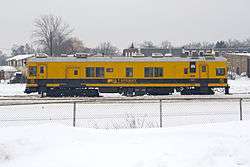Sperry Rail Service
 | |
| Founded | 1928 |
|---|---|
| Headquarters | Danbury, Connecticut, United States |
Area served | North America |
| Services | Rail Inspection |
| Website | www.sperryrail.com |
Sperry Rail Service is a company contracted by most of the major railroads in North America to inspect rail.
The rail flaw detector car was invented by Dr. Elmer A. Sperry. To railways and railfans, Sperry's name is most likely associated with the Sperry Rail Detector car.
Defect detection need
There were many early useless efforts of rail defect detecting device development in the late 19th century. Serious train derailments, which were blamed on transverse fissures, were increasing. One of them occurred in 1911, in Manchester, New York, killing 29 and seriously injuring 60. Another killed 21 and injured over 100 near Victoria, Mississippi, in October 1925. The need for dependable rail inspection became apparent.

First developments
Dr. Sperry began developing a method of locating internal rail defects in 1911. To build a railway test car he contracted with the American Railway Association in 1927. Construction on this first car began in June 1927. The body was metal-faced plywood, and was mounted on a Kalamazoo motor car bed. This car was towed by a larger motor car. After completion, it was delivered December 17, 1927, for performing tests. An operator, lying flat on his stomach as he was moved along on a hand car, held a 'search unit' against the rail. Both fissures were found, but serious difficulties were encountered during the test. This method also posed problems due to uneven rail surfaces.
Induction method
Dr. Sperry and his staff discovered a new principle for detecting transverse fissures in 1928, called the "induction method." It also found split-heads and other invisible defects. It did not function properly at the end of each rail where angle bars and bolts held two succeeding rails together. It also did not function properly where two rails converged such as at switch points. These rail parts had to be examined individually by a hand-held ultrasonic scanner. The induction system was used until 1960 when mobile semi-automated ultrasonic inspection equipment was introduced to the Sperry fleet. Ultrasonic rail testing was introduced in 1949.
Later redevelopments of 101 unit
It would appear that the induction-based testing method equipment replaced the original magnetic equipment on Sperry Rail Service 101. Even though it was completed almost ten months before, the car was rejected by the American Railway Association's Rail Committee until October 2, 1928. After a test run on September 27, 1928, by Dr. Sperry and his research engineer H.C. Drake, it began testing on the New York Central under ARA supervision. The test with the modified 101 was so successful that construction on SRS 102 began almost immediately.
Sperry Rail Service Corporation runs tests
The original plan of Dr. Sperry was to build and sell the rail detector cars, along with the testing services, to the railways. However, the railways were reluctant, so Sperry decided to sell the service only. It would lead to more consistent testing, which is done by skilled and experienced personnel.
- At this point Sperry Rail Service Corporation was created to market the testing service. The first commercial test was accomplished in November, 1928, on the Wabash Railway over a 130-mile (210 km) section of track between Montpelier, Ohio, and Clarke Junction, Indiana performed by SRS 102. The expansion of service put two more SRS cars into operation. In the early 1930 four cars were in service. By the end of 1930, Sperry Rail Service Corporation's fleet increased to ten cars.
- The fleet continued to expand along with the served area. In addition to services on U.S. railroads, the SRS cars also traveled to Canada, Mexico and overseas. Smaller railways could not afford their own rail detector car, with their limited use. However, the New York Central and the Union Pacific did own such rail detection cars. Many Sperry cars were created by rebuilding existing railway cars, particularly doodlebugs.
Takeover of Harsco Track Technologies
On August 29, 2002, Sperry Rail Service acquired Harsco Corporation's rail flaw detection (RFD) group. Harsco's track maintenance division, also known as Harsco Track Technologies (HTT), was located in Danbury, Connecticut, Sperry's home town. With this takeover Sperry's rail flaw detection fleet increased by 30 trucks. Harsco's Rail Flaw Service was previously known as Pandrol Jackson Technologies.
Track circuits
Track circuits are a means of detecting trains along a track section using an electric current. A train is detected when its wheels and axles form a short circuit between two rails. Track circuits can detect damage to rails if that damage results in a failure of the electric current, but will not detect other classes of failure.
Axle counters are another means of detecting trains, this time by a pair of sensors counting the number of wheels or axles that pass into and out of a given track section. Axle counters do not directly detect trains in between the paired sensors. Likewise they cannot detect problems with the rails between the paired sensors.
External links
- Sperry Rail Service corporate site
- Sperry Rail Service car roster
- A history of Sperry
- Winchester, Clarence, ed. (1936), ""Detecting rail defects"", Railway Wonders of the World, pp. 919–924 illustrated description of the Sperry detecting system